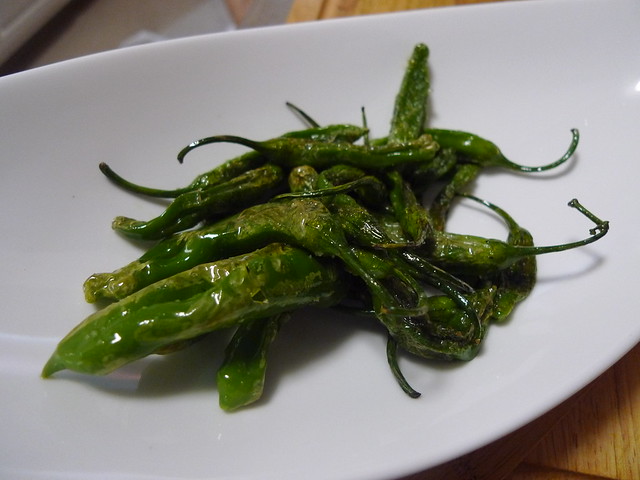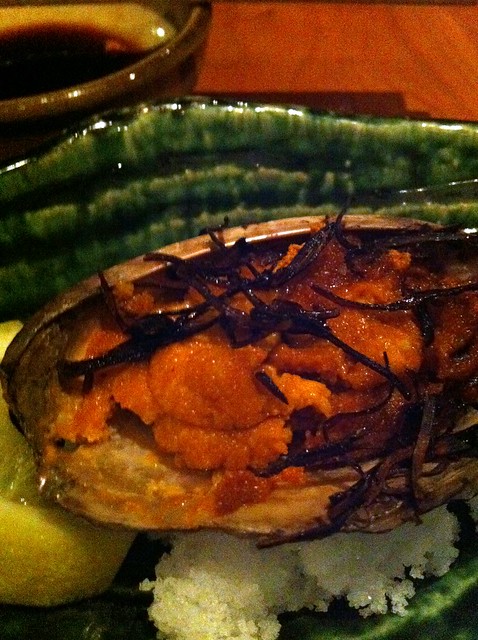I just summitted Kilimanjaro. I just summitted Kilimanjaro. I just summitted Kilimanjaro.
I still can’t believe we did it! After five days of hiking from camp to camp we finally made it to Uhuru Peak, the top of Kibo and the highest point in all of Africa at 19,340 feet.
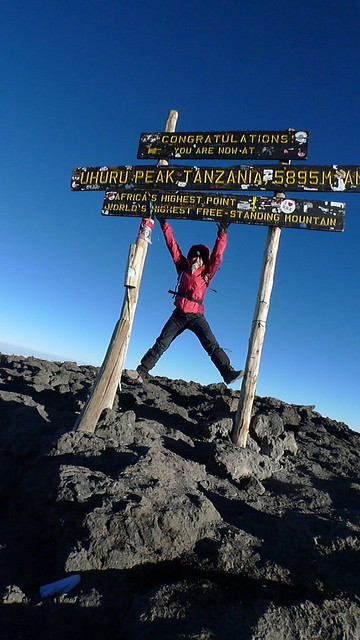
Around 11pm, I heard Peter M call my name right outside my tent. It wasn’t hard to wake up because I spent a sleepless and an uncomfortable night. Barafu was our highest and coldest camp yet. I met Scott and Christopher in the mess tent where we had our usual first meal of hot tea and coffee–it was both too late and too early to be eating porridge. After the porters handed us our water supply for the eight-hour summit, we suited up and started our walk out of Barafu Hut and into pure darkness.
I don’t think I realized at the time what eight hours of hiking in the dark could and would feel like. I felt that I was just along for the ride. After only four hours of sleep, I felt groggy as soon as I started to hear the crunch of gravel under my boots. Unable to see anything except what was being illuminated in front of us by our head lamps, there was nothing to keep us entertained; nothing to keep our minds off the robotic process of climbing Kibo in the middle of the night.
Crunch, crunch, crunch.
It was cold but I don’t remember freezing. I had thick snowboard gloves on over my usual winter gloves. I had a borrowed ski jacket (I stupidly forgot to pack mine!) on top of five layers of winter garb; four layers of pants helped my knees from feeling cold and two pairs of socks supported my feet without being too uncomfortable.
I don’t remember freezing maybe because I was literally sleepwalking the rest of the way. Godibless led the line and he kept turning around to give me a slight push on my shoulder to wake me up. Cia, no sleeping. Cia,don’t sleep. I asked if we could stop and rest several times so I may nod off, but Godibless stopped granting my request after the second one. I turned around a few times too to see if Samuel and the boys were still behind me. I barely heard a peep from them and I began to wonder if I was the only one having difficulty staying awake.
I also don’t remember feeling any pain because of the high altitude. I was just numb. As we gained a total of 4,140 feet, I started hallucinating. In my field of vision, I would see a pair of walking poles leaning against the boulders we were skirting around. I expected to see another group resting in front of us whenever I would look up from the poles, but no one was ever there. This happened twice until I finally realized that there was never anything in front of me except rocks. I started to talk to myself to stay awake and aware of my real surroundings. The funny thing is that I knew enough not to say anything to Samuel or Godibless lest they send me back down because I was going crazy.
Crunch, crunch, crunch.

The sun started to rise on our way to Stella Point which was named after the wife of Kingsley Latham, the South African king, who could only make it this far of the hike in 1925. All of a sudden, everything around us was orange and violet and everything in me was awaken. To my dismay, we still had at least 45 minutes until the summit. I felt like I just couldn’t walk anymore. I needed to lie down, rest and sleep.
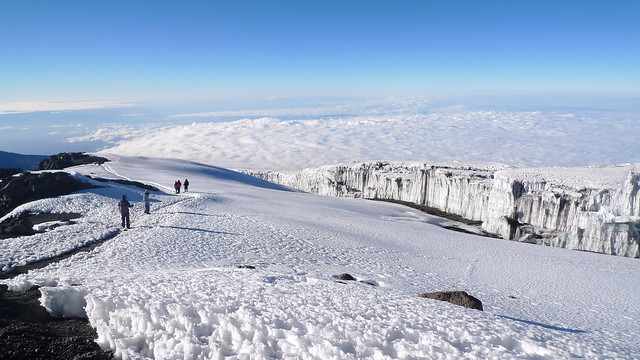
We started to see the glaciers people have been talking about all these years. Samuel confirmed that they have indeed receded from his ten-year experience hiking Kibo. Everything was so white that it hurt our eyes to look directly towards them as the morning sun illuminated the sky. The snow towards Uhuru Peak look like merangue puffs because of the wind. A single trail of dirt that cut through the ice led us to the finish line.
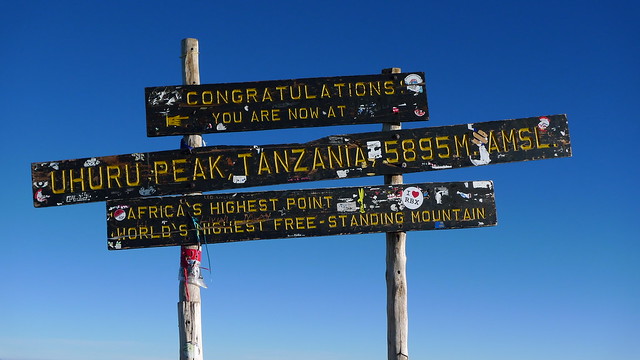
I was unable to speak when I finally got close to the infamous wooden sign of Uhuru Peak. (And not just because my face was wrapped in a ski cap and a scarf.) We stood close by waiting for our turn to take photos. The dots of light ahead of us when we were hiking belonged to these early risers–those were not part of my hallucination! We all made it this far and this high up and everyone congratulated each other for surviving; everyone was patient and waited for their turn in the spotlight.
When it was finally our turn to take photos, we posed, jumped, smiled, laughed and celebrated our accomplishment. Hugs and shaking of hands were exchanged and thank yous to Samuel and Godibless were delivered for helping us get up there. (The rest of the porters stayed in camp because they do not have the proper licenses to summit.)
What killed me was that we had to hike back down to Barafu Hut for the next four hours. You’d think that walking down a “short-cut” would be easier, but the trail was made up of ground rocks that felt like rough sand. All I kept thinking was, I’ve done what I wanted to do, now get me out of here. I couldn’t believe that I still had to keep working even after accomplishing that feat. Without enough sleep, I was extra crabby and whiny. Every other hiker slid down past me, seemingly enjoying their fast descent, but my left knee was acting up and I just couldn’t get the momentum to slide and go down all the way back to Barafu Hut.
The rest of the group made it down in three hours. Samuel stayed with me and my whimpering for an extra hour until I was able to drag myself from the bottom of Kibo, down some more sharp rocks and back to my tent at the edge of Barafu. It was noon and the sun was out in full force. All I wanted was to take my clothes off and sleep in my tent but then I heard Samuel say, Take an hour nap and then we go. It was a shock to me that even after eleven hours of hiking with only four hours of sleep the night before, we were still expected to hike another four down to our final camp. It made sense that we had to come back down on altitude and also go to a camp with a reliable water source, but not only was I not physically ready to keep on hiking, I was also not emotionally prepared to psyche myself up to continue to the real finish line.
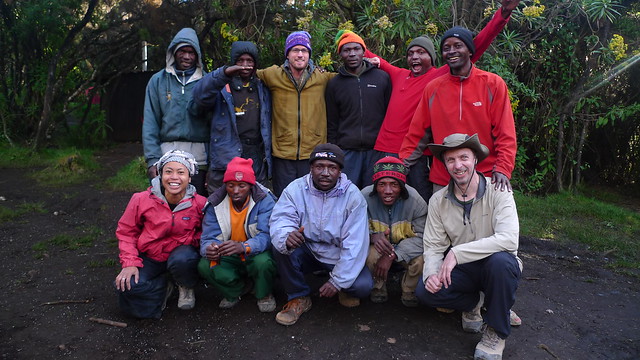
I slept like a log for that hour until Peter M woke me up again to eat lunch. I never felt so beaten. We haven’t washed our hands and faces for a full day and my contacts were so dried up after wearing them continuously during and after summit. Scott and Christopher showed such strong resolve that I knew I just had to shut up and do what we came to do. So more crunch, crunch, crunch until we made it past Millennium Camp and then to our base for the night, Mweka, where we bought the entire group cold bottles of Kilimanjaro beers to celebrate our week together.
Related post/s:
Hiking Kilimanjaro Day 5: Barafu Hut to Uhuru Peak to Mweka Camp photos
Hiking Kilimanjaro Day 4: Barranco Camp to Barafu Hut
